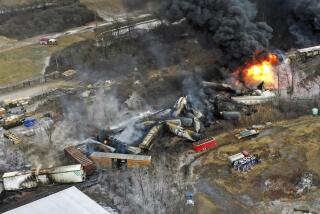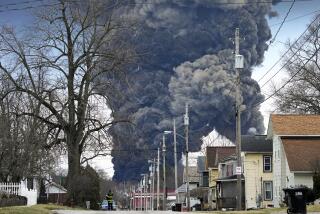Alerts for Runaway Trains Not Required
On a clear, cool afternoon in May two years ago, a locomotive pulling 47 cars escaped from a rail yard near Toledo, Ohio, heading south. The train reached speeds of 40-50 mph while carrying a highly toxic chemical known as molten phenol in two of the cars.
Within eight minutes, the railroad company, CSX, had alerted local officials, who credit this partnership with helping ensure that the incident ended without injuries or damage.
“I don’t even want to think about what would have happened if CSX hadn’t called us,” said Rose Chambers, the Wood County deputy sheriff who received the first call.
By contrast, when 31 rail cars began careering toward downtown Los Angeles last week, Union Pacific Railroad didn’t warn any communities in their path, including Commerce, where the cars derailed about half an hour later when dispatchers diverted them onto a side track.
The lumber-laden cars slammed into a residential neighborhood, flattening two homes and damaging several others. Federal investigators, in their preliminary report on the crash, highlighted the fact that Union Pacific had no procedures for dealing with a runaway train.
The incident has left Commerce residents angry that emergency crews were not alerted and has prompted the Los Angeles County Board of Supervisors to call for the creation of a plan to deal with runaway notifications.
Federal and state regulations grant rail companies considerable latitude in how they handle runaway trains. Companies are not required to alert local authorities to runaways, although most large railroads said their policies require them to do so.
“It is an area principally governed by the railroad companies’ internal control,” said Warren Flatau, a spokesman for the Federal Railroad Administration.
California’s Office of Emergency Response mandates that railroads report runaway trains that contain hazardous materials, but it does not dictate how quickly companies must do so. Union Pacific reported the Commerce runaway train to the state 14 minutes after it derailed.
Runaway trains are quite rare, Flatau said. But just days after the Commerce derailment, 70 Union Pacific freight cars rolled away from a Nebraska rail yard. No one was hurt in the incident Tuesday morning, and none of the cars were damaged, according to Associated Press.
Without specific regulations, rail companies have devised their own systems to alert communities as emergencies develop.
Union Pacific procedures did not include a specific plan to notify authorities of a runaway train, company officials said.
“We did not have the foresight to say, ‘Something is going to happen in Commerce and we should notify them,’ ” said Kathryn Blackwell, a spokeswoman for Union Pacific.
The company is not alone. “There is no manual for that,” said Preston Claytor, vice president for safety at North American Rail. “The federal regulations say don’t let the cars out of the yard in the first place.”
CSX and other major railroads, including Burlington Northern-Santa Fe, said their internal rules require dispatchers to contact special emergency communications officers when a train gets away. Those officers then call local authorities.
In the Ohio incident, CSX notified the local sheriff’s department a few minutes after the runaway train started moving. Sheriff’s dispatchers called in local emergency response teams that took up positions along the train’s route. Fire officials cordoned off rail crossings, gave CSX updates on the train’s movement and advised the railroad on the locations of heavily populated areas.
After 1 1/2 hours, CSX managed to chase down the train with another engine, which it attached to the runaway cars from behind, and slowed them down.
CSX said local authorities worked with company officials hundreds of miles away at the railroad headquarters in Jacksonville, Fla.
Other major railroads also handle emergencies from a central facility. Union Pacific’s Response Management Communications Center is in St. Louis. Federal investigators have said a focus of the Commerce crash probe will be why Union Pacific didn’t call local authorities.
Eric Larson, the director of emergency management in Wood County, Ohio, who coordinated response to the CSX runaway train, said that experience leads him to question the efficiency of a system that relies on a rail company’s sometimes-distant facility.
The distance between the response center and the incident built in an inherent lag time, Larson said. “They were not working in real time.”
Rail officials defended the system, saying that their officials are trained to deal with emergency notifications.
In Commerce, many residents say more needs to be done.
“How can they notify their crews on the tracks and not the people in the neighborhood?” asked Javiar Vazquez, whose house was partly damaged in the crash, referring to Union Pacific officials.
More to Read
Sign up for Essential California
The most important California stories and recommendations in your inbox every morning.
You may occasionally receive promotional content from the Los Angeles Times.










